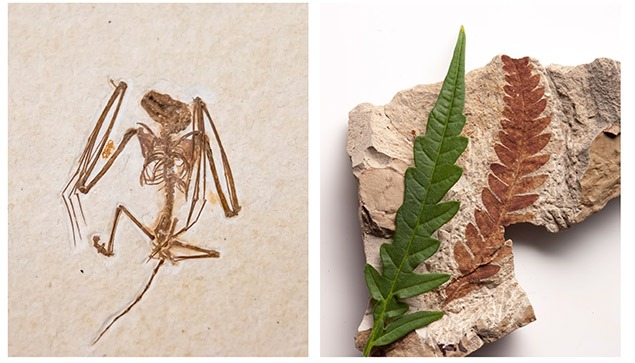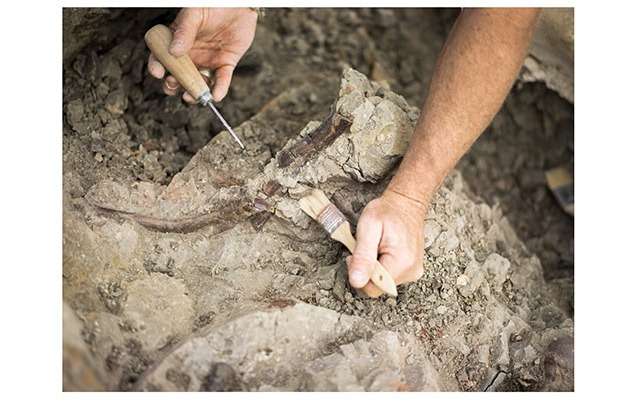How to go on a fossil hunt with kids
Dinosaur digs and other searches can be epic adventures. Here’s what you need to know to turn children into amateur palaeontologists…
Searching locally for fossils and artefacts with kids can be an epic journey – and inspire curiosity and exploration.
Here’s what you need to know to get started on a junior fossil hunting expedition, plus five extra activities for kids who love ancient life…
What exactly is a fossil?
Take heart, parents: you don’t need to know it all before you begin. Still, a bit of knowledge will set you off on the right track – and make you seem like a genius to your children.
Basically, a fossil is the remnant of ancient life. “They’re the remains of an extinct plant or animals or some trace of their behaviour, like a footprint or fossilised poop,” explains palaeontologist Scott Sampson, director of the California Academy of Sciences and author of the Nat Geo Kids book You Can Be a Palaeontologist!
The formula for creating a fossil goes something like this: a living thing dies, the soft parts decay, sedimentary rock builds up on top of what’s left, and water seeps into the bones and teeth to turn it to stone. Sometimes, water dissolves the bone or shell and leaves an imprint on the rock.

Right – Imprints of once-living things, like this leaf, are called trace fossils
While dinosaurs grab fossil glory, most fossils are actually something else, like trilobites from the sea and ancient insects sealed in amber. All fossils build an important bridge from past to present. “Any fossil we find helps remind us that we’re a piece of that narrative,” Sampson says.
How to start fossil hunting
Dedicated gear is not only fuel for excitement, but it also adds seriousness to the expedition. Pack a backpack with a shovel, small hammer of chisel, and brushes to excavate your finds (the closest equivalents you can scrounge up around the house will work too!)
Bring a notebook, pencils, and a camera for documentation. Don’t forget sunscreen, snacks, a hat, and water since many fossil-friendly spots don’t offer much shade.
The best fossil spots vary by be region, so it helps to do a bit of research ahead of time.
“You’ve got to have sedimentary rocks (that is, rocks that were formed by layers of sediment building up over time, like sandstone, chalk and limestone), and they’ve got to be exposed,” Sampson says.
Often, these are places where an ancient river flooded and then retreated into its channel, leaving behind layers of shale, sandstone or limestone and with it, fossils. To find nearby fossil-friendly spots, check out a geological survey or a paleogeographic map.
Look for places where rocks from long ago might be at the surface. Dirt-filled forests or newly landscaped locations will make your search more challenging. Deserts, quarries, or spaces where the earth has been split – like where roads have been cut into mountains or in cliffs on beaches or along rivers – are great spots.
Keep your searches safe and stay away from private property or public spaces where digging would be problematic, like sports fields. Check out this guide for UK top spots!
On the hunt
Children have a natural advantage when it comes to amateur fossil hunting: they’re closer to the ground, have better eyesight, and are curious about their surroundings.
“Kids are just natural scientists,” says Ilana April, senior manager of early childhood education at the American Museum of Natural History. “They’re born with a curiosity about the world around them.”
Of course, the chance of a child stumbling across a gigantic dinosaur skull is very, very small. But they might stumble on a footprint, ammonite or other more common fossil.
What to search for
It’s hard for even experts to describe exactly what to look for, because so many different types of fossils exist. That’s why April suggests that kids start their search simply by looking slowly and carefully along the ground. “The most important tool scientists have might be their eyes,” April says.
Then, stay on the lookout for interesting designs, patterns and textures. “I look for symmetry,” says Paul Mayer, palaeontologist and collections manager at Chicago’s Field Museum. “You want to train your eye to look for nice lines.” (Make our make-a-magnifier craft to help you out!)
For example, many shell fossils will have bilateral symmetry, so the left will be a mirror image of the right. Other times, texture will be the key.

Right – A gingko leaf fossil in North Dakota
“The fossil portion of a rock might be smooth or a different colour than the rest,” Mayer says. “It might really stand out, like a chocolate chip in cookie dough. Sometimes you’ll find it separate from a rock, but oftentimes you’ll find a fossil in the rock itself.”
If your kids spots something promising, have them use the shovel to dig out any half-buried rocks. The hammer and chisel will break away portions of rock that might expose a fossil, and the brush will wipe away any debris or dust.
After their discovery, kids should document the location and date of the find – and a description of the rock around it. “Someone else could figure out what the species or fossil is, but they’ll never know where you found it,” Mayer says.
Fossil or not?
After that, kids can try to figure out if their discovery is truly a fossil – and, if so, what exactly it is. If they think it’s a dinosaur bone, have a lick. Bones will stick to their tongue, while rock won’t.
For deeper research, kids can also try traditional sources (like books from Nat Geo Kids) or – under your supervision – fossil-hunting communities like the My Fossil emuseum.
The most important lesson of fossil hunting is to keep at it. “You never know what you’re going to find,” Mayer says. “The more rocks you look at and pick up, the better your chances are of finding a fossil.”
Going beyond fossil hunting
Discovering the world of dinosaurs and ancient living things isn’t just about digging. Here are five other activities to connect with the past…
Track living dinosaurs
Blow your kids’ minds by tossing out this fact: dinosaurs exist today as birds. Take your kids bird-watching (or keep an eye on the birds from your window) and see if they can find similarities between the dinosaurs in their books and the ones in the trees.
Search for ancient plants
“Certain species of plants that grow today were also around during the Ice Age and eaten by giant sloths and mammoths,” Olson says. Look for trees like ginkgo, palms, magnolias, avocados, and even ferns, then imagine what creatures might have been chowing down on them millions of years ago.
Find fossils of the future
Insects still get stuck in tree sap, under a rock, or inside tar (even if it’s just on your driveway). Have kids search the fossils-in-the-making to compare with ancient versions.
Create a fossil record
If your kid’s find is in a protected space – or you just don’t want a bunch of rocks cluttering up the house – create a memento with an old-school rubbing technique.
Hold paper against the unique portion of the rock and rub against the section with a crayon, marking what is raised. (Even if they don’t find a fossil, doing this activity with things like tree bark, leaves, or textured stone is still a great way to capture an adventure.)
Trace nature’s patterns
Palaeontologists use fossil finds to understand the behaviour of ancient living things. Have kids use their own investigative skills – and a bit of creativity – to follow clues that today’s creatures might leave behind. For example, broken acorns could mean a nearby squirrel’s nest – or nearby poop.














LEAVE A COMMENT
THANK YOU
Your comment will be checked and approved shortly.
WELL DONE,
YOUR COMMENT
HAS BEEN ADDED!
COMMENTS
CUSTOMIZE YOUR AVATAR